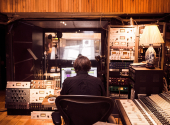
5 Ways to Make a Great Cover
From time to time, I meet someone who claims, in a more or less dismissive tone, that there’s nothing new to invent in music anymore and all songs are just repetitions of the same thing. While I don’t fully agree with that statement, indeed, not every musician always has to write original songs. Your creativity, originality and musical skill can also shine through when interpreting songs written by someone else. Classical and jazz musicians know this well. Let’s look at the different ways to make a good cover, because it can mean much more than just “playing someone else’s song”.
1. Acoustic cover
An acoustic cover is when you grab a guitar at a summer bonfire and play Knockin' On Heaven's Door. Nothing more, nothing less. Just you and your instrument (ideally an acoustic one, given the name). But it’s also an acoustic cover if you plug your acoustic guitar into an amp at home or out in a town square, sing into a mic and record the whole thing on video. The degree of electrification doesn’t really matter. What does matter is your voice and your unique expression, which are the focal points of this type of cover.
If you search this term on YouTube, you'll see it’s by far the most common type of cover for any song. The reasons are practical – it’s the simplest thing you can do with a “borrowed song”. Yet it never seems to bore listeners. Each performer brings a different voice, tone and emotion. Visual and sound quality, not to mention musical skill, can vary greatly. If you’re drawn to this approach, it pays off to invest time into creating an attractive visual setup, properly configuring mics and lighting, and learning the basics of using a DAW and video editing.
That said, it’s not always crucial. An American acquaintance of mine regularly posts acoustic covers on YouTube that are, let’s say, questionable in terms of quality – yet he racks up views that many local indie bands writing original music would envy. Sometimes, quantity matters more than quality – at least in the eyes of the algorithms.
If you want to include an acoustic cover in your live show, a little planning ensures it’ll hit the mark. Usually, the more noise your band makes, the more impact a stripped-down moment with just guitar or piano can have. It immediately creates a more intimate vibe and lets your audience get closer to you. But be mindful of the concert’s flow – this kind of cover doesn’t belong at the start or during the final climax (unless the whole gig is unplugged). It works best as a breather or an encore piece.
2. Metal or reggae?
If you’ve ever searched for different versions of the same song, you've likely come across these. A metal cover of The Scientist by Coldplay. A reggae version of Paranoid by Black Sabbath. Smells Like Teen Spirit turned into Celtic rock. Or disco. The crazier and more surprising the contrast, the better. Covers span a wide range, from odd mashups to masterful remakes faithful to genre conventions.
For years, I’ve been part of a small international musician community where we run a regular “Cover this song” challenge – everyone records their own cover of the same track. While some results are questionable, I’m always amazed at how many different and often really good (or at least fun) versions can come out of a single song. If you like experimenting and genre-hopping, this might be your path.
Some musicians on YouTube have built their success on such remakes, like the well-known metal covers from Frog Leap Studios. While they might seem like humorous stunts with some props and wild antics, a closer look reveals top-tier musicianship and meticulously arranged songs. If you're aiming to release your cover in a new genre, at least respect the basic rules of that genre. There’s nothing worse than, say, a reggae version based on a single track you vaguely remember from years ago.
The same goes for live shows. If your band plays metal and you throw Radio Gaga into the set in your usual style, fans will probably enjoy it. But if you're an indie rock band trying a metal cover, it’s likely to come off as cringey.
3. Note by note
While previous approaches focus on originality and creativity, this type of cover aims to replicate the original as closely as possible. It’s a paradox – we strive to find our own voice, sound and unique musical identity, yet spend hours trying to perfectly mimic someone else. Apart from tribute bands, is there value in such precise imitation?
A friend of mine spent all last year recording a full cover of The Wall. Friends helped with some parts, but he did most of it himself – and amazingly, he pulled it off. The result is actually great. You can tell that album is close to his heart. And if you dissect a legendary recording, try to understand it and then rebuild it yourself, you learn a lot. Learning a beloved solo, bassline or riff is a key way musicians improve – so why not apply it to an entire song or even album?
There are also YouTube examples where this works brilliantly – like the Martin Miller Band, whose playing is so good that some of the original artists they've covered have come to jam with them! This band of studio pros draws millions of views with medleys that, for example, smoothly shift from Kiss to Bee Gees.
4. Different instrument? No problem!
Another reliable cover approach is changing the instrumentation. Using different instruments forces you to rethink the original arrangement, often with fascinating results. The same goes for vocal swaps – a male singer covering a song originally sung by a female vocalist, or vice versa. Orchestral arrangements of rock hits are also popular.
You can try this even when recording solo at home. Break down each instrument and think creatively – can that guitar riff be replaced by a bassline? Can drums be swapped for interesting samples? What if you replaced backing vocals with keyboard harmonies, or vice versa? Beyond having fun, this helps you think more deeply about the arrangement – which parts are essential and which can be dropped?
5. Remake, mashup, remix – where is the line?
In our "Cover this song" challenge, the same question keeps popping up: Is this still a cover? When does a track become so altered that it’s no longer recognisable? There’s no simple answer. But if your intention is to make a cover, the original song should still be identifiable. Especially if you plan to release it officially as a cover, you need to retain the lyrics and lead vocal melody, and it’s recommended to keep the core harmony and structure. You can play with tempo, arrangement, instrumentation, backing vocals, etc., quite freely.
But there are other ways to work with songs written by others, like creating a mashup, blending two or more unrelated songs. Maybe one flows into the other, or you combine the vocals of one with the music of another. Today, many songs are available in separate tracks, and even those that aren’t can be split using advanced AI tools. You can create a remix or pull certain parts from the original and add your own. Whether you record your vocals over an existing backing track karaoke-style or use the original vocals with your own music, there are lots of options. The boundaries keep blurring, and the possibilities are expanding rapidly.
And what about the law?
If you’ve read this far, you’re probably wondering: what about copyright? What’s allowed when it comes to covers? This topic deserves its own article, as there are many grey areas, and legal regulations are struggling to keep up with the real-world pace, especially with the rise of AI tools.
In the meantime, here are a few practical notes. Basically, you should never present someone else’s song as your own – always credit the original author in recordings, videos and even setlists. If you're a band that mostly plays originals but wants to include a cover at a gig in a venue that requires a setlist, just report the song on the list. That’s it. You don’t pay anything – reporting to organisations handling authors’ and performing rights is the organiser’s (venue’s) job. It’s different if you’re a cover-only band and earn money from it (e.g., a wedding or party band) – in that case, it’s best to obtain performance licenses from those organisations.
If you want to record and release your cover, different platforms have different rules. On sites like SoundCloud or YouTube, your upload may be flagged by algorithms. In practice, though, this rarely happens – especially if your YouTube channel isn’t monetised.
To release your cover on platforms like Spotify or Apple Music, there are services that handle royalties for cover songs – the most well-known being Soundrop. You can also release covers via DistroKid, Landr or CD Baby, which all offer special options for cover distribution.
What are your favourite covers? Let us know in the comments under the article on Facebook!
If you have found an error or typo in the article, please let us know by e-mail info@insounder.org.





